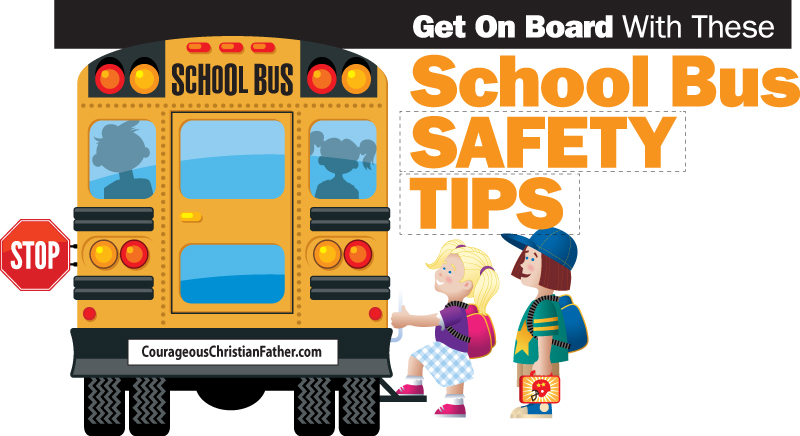Get On Board with these School Bus Safety Tips – With Back to School time comes some children riding the big yellow school bus. #SchoolBusSafety #SchoolBus
Maintaining school bus safety is of the utmost importance. Students, parents and the school district can work together to make security a priority.
Being safe while en route to and at the bus stop is just as important as staying safe while riding on the school bus.

School buses are safe modes of transportation for children. Statistics from Transport Canada indicate that transportation by school bus is safer than by passenger car. School buses are large and heavy vehicles that protect riders during collisions. School buses also help keep a greater number of passenger vehicles off of the roads during high-traffic school times.
The National Highway Traffic Safety Administration says that each year approximately 450,000 public school buses transport 23.5 million children to and from school and school-related activities around the United States. Although safety is enforced while students are on the bus, it is also vital for students to remain safe before they board. Ensuring a safe bus stop requires diligence.
Below are some school bus safety tips and more.
Safety starts with students and parents.
Students are under the authority of the bus driver while they are on the bus. But before they board the bus, students typically are not supervised. Chaperoned bus stops can help deter rowdy actions, particularly at crowded bus stops. Parents can rotate standing watch and keeping tabs on bus stop behavior.
Arrive early at the bus stop.
Accidents can happen when people are rushing and not paying attention. NHTSA advises getting to the bus stop at least five minutes before the bus is scheduled to arrive.
Rushing to the bus stop may cause you to make errors in judgment, including running in traffic to catch the bus. Leave early so you have ample time to catch the bus and obey all traffic laws.
Stand at a safe distance and at your designated stop
Children should remain no less than six feet away from the curb or roadway while waiting for the bus to arrive. Parents should routinely remind students not to run and play at the bus stop.
Always stand on the sidewalk, lawn or curb where the school bus stop is located. Stay away from the street because traffic in the morning and the afternoon can be very busy and hectic.
Lobby for safe bus stop locations.
District transportation directors are often tasked with choosing school bus stop locations based on local policies and attendance. Only basic requirements may be addressed, such as distance between stops. Parents and community members might be able to offer feedback regarding roads with low traffic volume and spots that offer maximum visibility during all seasons.
Minimize street crossings.
Parents can drop children off on the side of the road where the bus will stop so the kids do not have to cross roadways unattended.
Use traffic assistance whenever possible.
Children who walk to bus stops are urged to walk in crosswalks and on sidewalks and obey traffic controls. Parents can work with their children to find the safest routes to the bus stop, such as on residential streets rather than high-traffic roadways.
Familiarize yourself with the route to the bus stop.
Parents are urged to research the area and know where potential hazards on the route to the bus stop may lie. This includes potential human hazards. According to BusBoss, a school bus routing and tracking company, it’s important for parents to know where registered sex offenders live and ensure kids avoid these homes on the way to the bus stop. Other hazardous areas include spots where drug activity or other illegal behavior occurs.
Drive cautiously during school hours.
Drivers should exercise extra caution and reduce speeds when schools are opening and closing. There will be lots of students on the roads between 8 and 9 a.m. and again between 2 and 4 p.m.
Only board and exit the bus when it is safe.
Wait for the bus to come to a complete stop before boarding or exiting. The driver will engage the stop sign and put on the flashing red lights. Move around the bus only when it is stopped.
Keep the aisles clear.
Stay out of the aisle when the bus is in motion and store backpacks on your lap or under your seat so they are not tripping hazards.
Use seat restraints.
Use seat restraints when available on the school bus. While not every school bus has seatbelts, many now do.
Stay in your seat.
Remain in your seat while the bus is in motion. Keep your hands inside of the windows. Do not get up to engage with other riders.
Keep a good distance between you and the bus.
Exit the bus and cross in front where the driver can see you. If you cannot see the driver, he or she cannot see you. Check for safety signals from the driver to proceed when traffic has stopped. Always walk, never run, around a bus.
Do not goof off.
When on the bus, always behave so that you can hear any safety instructions and be aware of your surroundings. Behaving also means one less distraction for drivers.
Utmost Importance
The National Highway Traffic Safety Administration says that each year approximately 450,000 public school buses transport 23.5 million children to and from school and school-related activities around the United States. Although safety is enforced while students are on the bus, it is also vital for students to remain safe before they board. Ensuring a safe bus stop requires diligence.
Each day thousands upon thousands of children board school buses to take them to and from school. Parents and caregivers entrust their children’s well-being to the care of school bus drivers and aides. Although parents may worry about school bus accidents, such accidents are few and far between.
The National Highway Traffic Safety Administration advises that school buses are designed to be safer than passenger vehicles in avoiding crashes and protecting against injury. Buses are arguably the safest mode of transportation for getting kids to and from school. By keeping millions of cars off the roads surrounding schools, school buses contribute to less crowded roadways, which are less conducive to accidents.
Danger zone
Though parents may feel buses are most likely to be in accidents while in transit, experts advise that children are more likely to get hurt during pickups and drop-offs when they’re in the “danger zone” of the bus. The danger zone is a 10-foot radius around the outside of the bus. Bus drivers and other motorists find kids in the danger zone are more difficult to see, and children can get struck by either the bus or oncoming cars that fail to stop when the bus is picking kids up or dropping them off.
Knowing the safety rules
While a large part of protecting children is on the shoulders of the school bus driver, it is also vital for passengers to learn the basics of school bus safety. Kindergartners or children who are riding the bus for the first time should be taught the rules of school bus safety.
Some schools offer a school bus tour prior to the new school year. This lets youngsters acclimate themselves with the look and feel of the school bus. This introduction also may include information about bus safety, but parents can also educate their children (and themselves) about using caution in and around the bus by following these guidelines.
Additional Tips
- Get to the bus stop 5 to 10 minutes prior to the assigned pickup time. Rushing last-minute can lead to injury, especially if you’re chasing down the bus.
- Remain on the sidewalk or grass at the bus stop. Do not step off the curb into the street until the bus has arrived and is completely stopped.
- When boarding the bus, go directly to a seat and sit down. Buckle up if there are seatbelts on the bus.
- Remain seated while the bus is in motion.
- Keep voices low so as not to distract the driver.
- Keep your head and hands inside of the bus, and never hang out of the window.
- Do not throw things on the bus or play rough with friends or classmates.
- Keep the aisle clear at all times.
- Be careful when getting off the bus. Hold on while going down the stairs.
- Only get off at your designated stop unless you have permission to get off elsewhere.
- When exiting the bus, walk at least 10 steps past the front of the bus and cross in front where the driver can see you. Do not cross behind the bus.
- Wait for the driver to give you a signal that it is safe to cross. Be sure to check that all cars on the road have come to a complete stop.
- Get to the sidewalk or off the street as quickly as possible.
- If you’ve forgotten something on the bus, do not run back and attempt to retrieve it. The driver might not see you and start the bus. Rather, call the bus company and see if you can pick it up at another time.
- Do not get into the cars of strangers waiting around bus stops, even if they offer to take you home.
Arrangements Made
Parents can arrange to meet with bus drivers so that they will recognize their faces. Adults also can encourage schools to host bus safety courses to further ensure their youngsters are safe.
National School Bus Safety Week
Held during the third full week of October each year, National School Bus Safety Week is an active and evolving public education program and an excellent way for parents, students, teachers, motorists, school bus operators, school administrators, and other interested parties – to join forces and address the importance of school bus safety. Designed to promote school bus safety, school districts throughout the country observe School Bus Safety Week.
2019: October 21-25
Closing
Millions of students rely on public transportation to get them to and from school each and every day. The National Safety Council says 25 million students in the United States begin and end their school days on school buses. The NCS adds that riding a bus to school is 13 times safer than riding in a family vehicle and 10 times safer than walking.
Although buses are designed for safety, student riders can do a lot to make their bus trips even safer.
School bus passengers can make their rides to school even safer by playing it smart.
Combined Articles compliments of MetroCreative. BS137272 BS177113 BS167239
First published August 8, 2018. Last July 31, 2019.
About the Author
Discover more from Courageous Christian Father
Subscribe to get the latest posts sent to your email.



Thanks for the tips! I really like that you added the tip “Drive cautiously during school hours”. I think that is the most important one of all!
Thinking about that, we should drive cautiously all the time.
My kids are starting to get to the age where they are starting to walk to school and while there are crosswalks I worry about if drivers will see them. I can see how it could be really useful for the school to get some system with flashing lights that can alert drivers to when people are crossing so that they are safer. I’ll be sure to tell them that they should be sure to use crosswalks as much as possible and not just jaywalk.
I often think people are not even responsive to flashing lights anymore either. Safety walking, on the bus, etc. We have to be aware of our surroundings at all times. Part of that is not having our nose in our phones either, especially when we are walking.